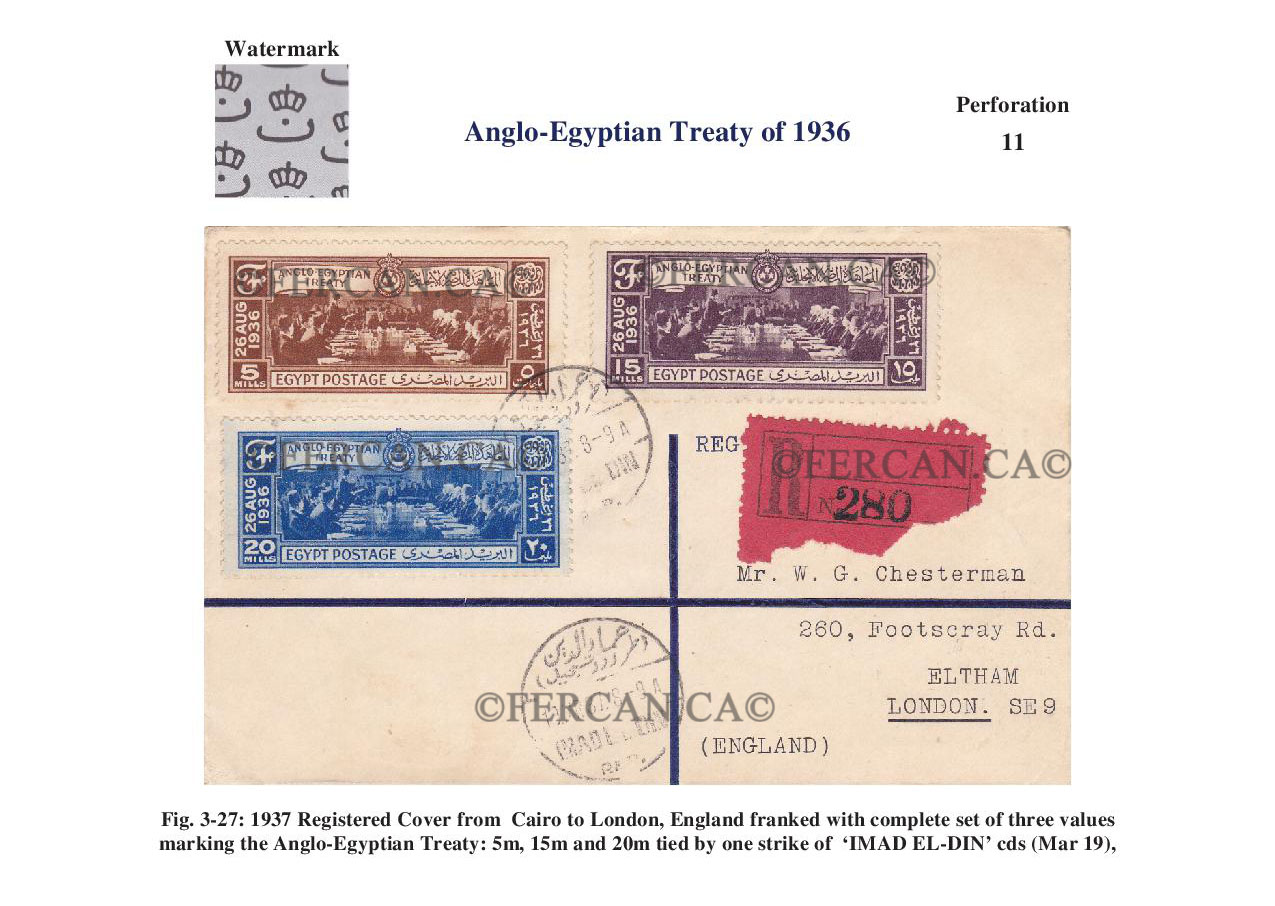26 August 1936 - Anglo-Egyptian Treaty Photogravure by the Survey Department, Cairo. Usage valid until 22 March 1937.
The Anglo-Egyptian Treaty of 1936 was signed between Britain and Egypt on 26th August 1936 at Zaafarana Palace in Cairo. The treaty came after a government announcement, upon the death of King Fouad, that his son Prince Farouk would ascend to the throne. Due to his young age, a trusteeship council was appointed, and then the Wafd Party formed the government because of its triumph in parliamentary elections. It demanded negotiations with Britain about the Four Reservations. The British government declined, so protests broke out. A national front was formed to bring back the 1923 constitution, instead of the 1930 constitution. Consequently, Britain was obliged to retract and become involved in negotiations under the leadership of Sir Miles Lampson, the British High Commissioner, his assistants and the Egyptian Negotiation Board. Britain stipulated that negotiations should be held with all parties to ensure their consent. They all participated except for the National Party, which raised the slogan ‘No negotiation until evacuation’. The negotiations were launched in Cairo at Zaafarana Palace on 2nd March, and ended with a treaty on 26th August 1936 in London.
Anglo-Egyptian Treaty of 1936
This treaty, between Britain and Egypt, was signed on behalf of Egypt by the Egyptian Prime Minister Mustafa Al-Nahas on 26 August 1936 at Zafarana Palace. The Wafd Party formed the government and called for negotiations with Britain on the Four Reservations in the 28 February 1922 declaration:
Terms of the Treaty:
1. British military forces will be transferred from Egyptian cities to the Suez Canal Zone, and British soldiers will continue to be stationed in Sudan unconditionally.
2. The number of British forces in Egypt will be determined, with no more than 10,000 soldiers and 400 pilots, in addition to the necessary staff for their administrative work.
3. British troops will not move to new zones except after Egypt has built barracks in accordance with the latest systems.
4. British forces will remain in Alexandria for eight years from the commencement date.
5. British air forces will remain in their camp in the Channel Zone and be allowed to fly in Egyptian air space the same as Egyptian aircraft.
6. In case of war, the Egyptian government will commit to providing all facilities and assistance to British forces and they will be entitled to use Egyptian ports, airports and roads.
7. After twenty years of implementing the treaty, the two parties will review the situation and decide if the presence of British troops in Egypt is still necessary.
8. Egypt has the right to demand abolition of the capitulations.
9. All agreements and documents that are contrary to the provisions of this Treaty shall be cancelled, including the 28 February Declaration and its four reservations.
10. The Egyptian army will return to Sudan and joint responsibility with Britain will be recognized.
11. Egypt will be free to hold political treaties with foreign countries under the condition of its consistency with the provisions of this Treaty.
12. Egypt will exchange ambassadors with Great Britain.
In March 1950, the government of Al-Nahas demanded to enter into new negotiations with the British government. Those negotiations continued for nine months during which time the British became very strict, forcing Al-Nahas Pasha to announce his boycott of the negotiations and abolition of the Treaty of 1936 and the Conventions of Sudan. He presented decrees to parliament, including bills that included the abolition. The parliament ratified them and laws were issued to confirm the abolition, which resulted in termination of the alliance between Britain and Egypt. The British forces in the Canal Zone were considered occupying forces. Consequently, a struggle began once more, and this time it was an armed struggle. When the Anglo-Egyptian Treaty was signed on 26 August 1936, the Minister of Finance proposed issuing a commemorative set of stamps and arranged to have a suitable photograph taken of the signing ceremony in London.

